The MacBook Pro Review (13 & 15-inch): 2011 Brings Sandy Bridge
by Anand Lal Shimpi, Brian Klug & Vivek Gowri on March 10, 2011 4:17 PM EST- Posted in
- Laptops
- Mac
- Apple
- Intel
- MacBook Pro
- Sandy Bridge
Performance
For our performance comparison I actually dusted off some of our 2008 8-core Mac Pro data just to show you exactly how close to a high end desktop the new quad-core MacBook Pro has come. Note that we only have comparative data for a few benchmarks so you may see the Mac Pro disappear from a few charts.
Keep in mind that the Mac Pro numbers are taken with a 3.5" hard drive (vs. the 2.5" HDD in the MBP). The big difference however is microprocessor architecture. In 2008 the Mac Pro was still running Core 2 based CPUs, while Sandy Bridge is two tocks away. What the new MBPs lack in TDP headroom and core count, they can make up for in clock speed. The result is that for the first time since I've been reviewing Apple hardware we have portable Macs that can truly hang with their desktop brethren (with some caveats of course). In order to truly bridge the mobile/desktop gap you definitely need an SSD; a 2.5" hard drive just isn't going to cut it. The Mac Pro still has a pure core count advantage. The reason I feel like the mobile/desktop gap has narrowed is because while I feel that there is a general performance benefit when going from 2 to 4 cores, it's far more difficult to find applications or usage models that take advantage of 8 or more cores.
The gap will grow once more as the iMac and Mac Pro get updated with Sandy Bridge hardware later this year, but I suspect that for even desktop users a 15-inch MacBook Pro paired with an external display may be near perfect. I believe this is a big reason for pushing Thunderbolt in this generation. While the standard may not really take off until next year, the new 15-inch MBP is definitely built for desktop replacement usage models and for that to work without sacrifice you need high speed external storage.
Adobe Photoshop CS4 Performance
The Retouch Artists Speed Test we use for our CPU testing under Windows also works under OS X. We're running the exact same benchmark here, basically performing a bunch of image manipulations and filters and timing the entire process.
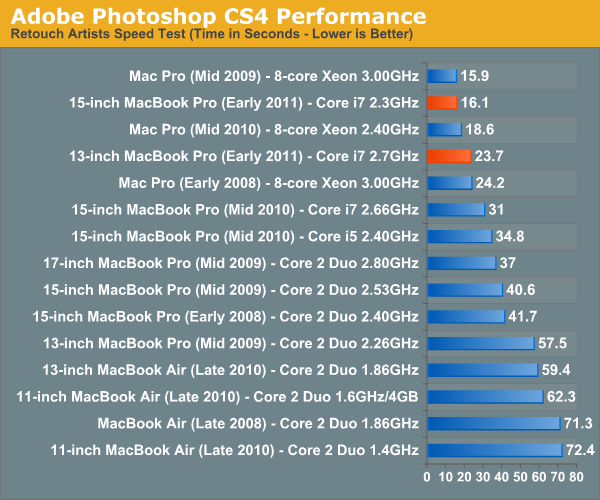
Photoshop performance is just amazing on the new systems. The high end 15-inch MacBook Pro is actually faster than last year's 8-core Mac Pro. Of course this is because Photoshop doesn't scale perfectly with core count but it just shows you just how powerful these new quad-core CPUs are.
Owners of last year's 13-inch MBP will notice that the new high end 13-inch can run through our CS4 test in roughly half the time. The performance improvement is of course exaggerated because Apple kept the 13 on Core 2 for longer than it should have, but what's important is that the new 13 is really fast.
If you do a lot of Photoshop work, the Sandy Bridge upgrade will be worth it.
Aperture 2 RAW Import
For my Aperture test I simply timed how long it took to import 203 12MP RAW images into the library.
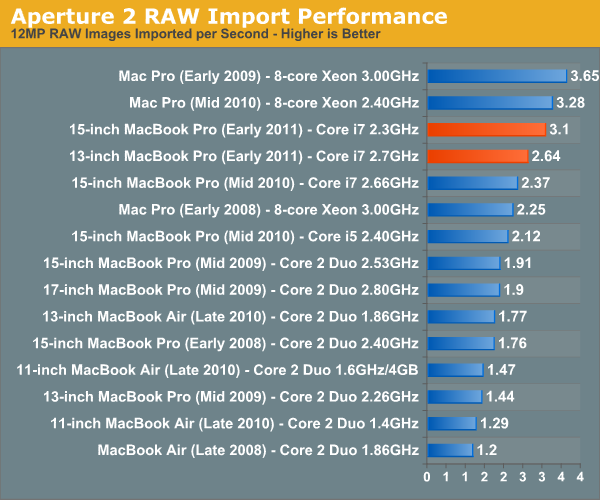
Aperture performance is similarly class leading. Here the 2010 Mac Pro actually outperforms the high end 15 by around 6% but the fact that we can even mention the two in the same sentence is huge.
The new 13 is still really quick, itself faster than a Mac Pro from as recently as 2008 in this test.
Cinebench R10 & 11.5
I’m a fan of the Cinebench tests because they lets me show off both single and multithreaded performance in the same workload. First, the single threaded performance:
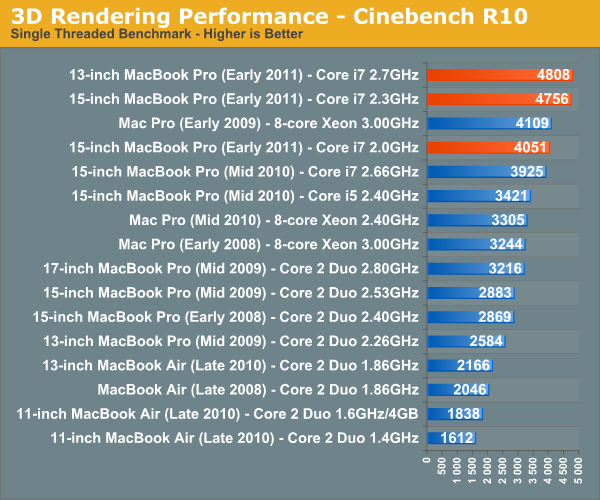
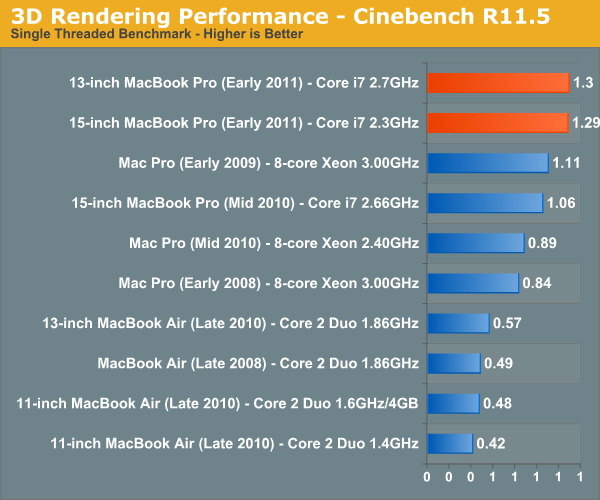
Single threaded performance is really where these systems shine and it's what makes them feel so fast in normal usage. Even the base 15-inch MacBook Pro has better single threaded performance than last year's high end model.
You'll notice that the 13-inch 2.7GHz MBP has a bit of an edge compared to the 15-inch 2.3GHz system here. Although both chips can technically turbo up to 3.4GHz with only one core active, Apple seems to limit the 13-inch dual-core less. As a result it will sometimes have higher single threaded performance than the 15. I noticed this in actual usage as well. The advantage is very subtle and really only visible if you do a side to side comparison however.
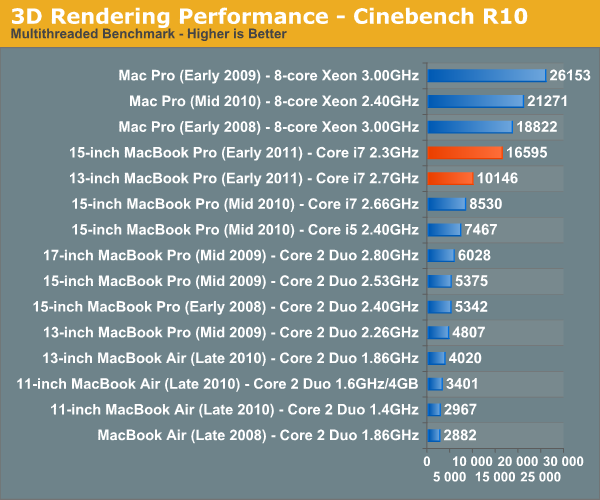
Multithreaded performance is obviously a huge boon on the 15-inch MacBook Pro. With four cores and eight threads the new 15-inch MBP behaves a lot more like a desktop than a notebook. Multithreaded performance is also one area where the high end Mac Pros do a lot better as they have twice the cores of even the 15-inch MBP.
Quicktime H.264 Video Encoding
Our final benchmark is more consumer focused. Here I'm taking an XviD and converting it to an iPhone-supported H.264 format.
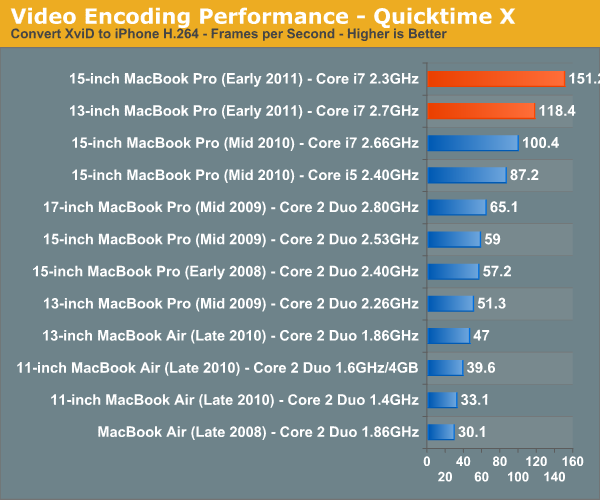
Despite missing Quick Sync support, the 2011 MacBook Pros do very well in our video transcoding tests. If Apple does get around to enabling Quick Sync you can expect the performance advantage to grow even more.










198 Comments
View All Comments
Pandamonium - Thursday, March 10, 2011 - link
I own a 15" 2010 MBP and like the author(s) of "The Big Picture" section, I like using separate peripherals at home. I don't want to come off like I'm giving a sales pitch, but after a long wait, I bought a Henge Dock for my MBP. It's a $70 plastic mold whose only purpose is to hold your cables in place so you can easily/quickly "dock" a MBP.For security concerns, I made an encrypted volume with OS X's disk utility and keep my frequently accessed sensitive stuff there. Everything else sits on my NAS.
I control heat and noise with SMC Fan Control. I've got a profile to keep "docked" fan speeds just a notch faster than default (the fan speed ramping up and down irritates me more than the absolute noise of the fan), and another profile for "lap use" to keep the machine at a comfortable temperature.
I too think that Thunderbolt is a big step towards an Apple docking station, but for now, the Hengedock, a NAS, and SMC Fan Control give me a solution that while not as elegant, is 95% of the way there.
Pandamonium - Thursday, March 10, 2011 - link
I should add that I use a Synology DS 209. If I could do it all over again, I'd go with QNAP. See my comments on Ganesh's Synology review for my reasoning. Cliffnotes are that I believe that regular SMART tests (to detect bit rot) should be part of a NAS's software stack and Synology's PR begs to differ. I'd love for Anand to offer clear advice one way or the other.dagamer34 - Thursday, March 10, 2011 - link
Does high amounts of heat ever mess up the screen or affect the dissipation of heat? I'd get worried if I were running a render or playing a game that caused my MBP to hit higher than the 80C it does now and the laptop just shuts itself down because it's too hot.dagamer34 - Thursday, March 10, 2011 - link
Based on this review and using a 17" MacBook Pro (2011), here's my advice:13" MacBook Pro - the changes from the 2010->2011 are good if you do CPU tasks, but mediocre to lame for GPU tasks. If you want to game, I'd wait until Ivy Bridge with a better GPU. Hopefully, we'll also see something more radical with ditching the optical drive allowing for a larger battery and dedicated GPU, but we'll see how that turns out.
Base 15" MacBook Pro - very good if you have CPU driven tasks, and what I'd recommend for most people. The only offsetting thing I see is that the next step up has a CPU, GPU, and VRAM bump, which may be very enticing for gamers.
High-end 15" MacBook Pro - for gamers, with the most optimal CPU, GPU, and VRAM configuration there is while still being very portable.
17" MacBook Pro - you love high-resolution screens for your work but still need to be portable. Very ideal because of the ability to have a full 1080p picture on the screen untouched for editing websites and such. Also good for photoshop. Likely for people that feel having an additional monitor is too much work, or their second monitor should be comparable in screen resolution to their main one.
I do hope the 2012 MacBook Pros cut away a lot of the fat: optical drive, FireWire port, USB port, ExpressCard slot and just have most of that functionality replicated with ThunderBolt. I feel like they could have gotten away with it this time, but there were no peripheral style docks ready, which is rather disappointing.
Ushio01 - Thursday, March 10, 2011 - link
Optical drives are still essential for those of us in the majority of the world who's internet is useless not to mention you never know if throttling or low data caps will be introduced in area's with currently good internet access subsequently making the loss of an optical drive a drawback.Also interesting phrase cutting the fat or in other word's continue paying for a premium product but get even less for your money, yay.
dagamer34 - Thursday, March 10, 2011 - link
That's what the $79 External SuperDrive is for.Ushio01 - Thursday, March 10, 2011 - link
Yay pay $1200+ for a laptop then pay $80 for the ability to use anything on it.khimera2000 - Friday, March 11, 2011 - link
Its apple your paying out of the @$$ any how. If you where going for a budget, or "price VS performance" you would not be considering an apple. I think people looking at these will have 80 bucks to spare... at least be able to scrounge up 80 bucks when the need arives.mianmian - Thursday, March 10, 2011 - link
Yeh. Apple should have the upgrade option to replace optic drive to1. a 2.5" drive slot
2. an extened battery.
gstrickler - Thursday, March 10, 2011 - link
I doubt you'll see either from Apple, however:For #1, an OptiBay from MCE (MCEtech.com), or a DataDoubler from OWC (macsales.com). The MCE offers an external USB case for the removed SuperDrive so you still have the use of the SuperDrive, and it's USB powered so it's still portable.
For #2, HyperMac (hypershop.com) sells external portable batteries for the MB/MBP.